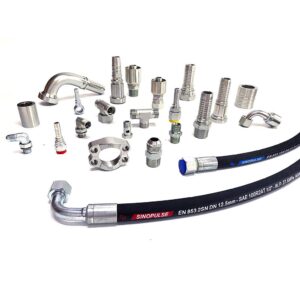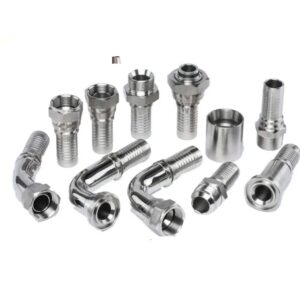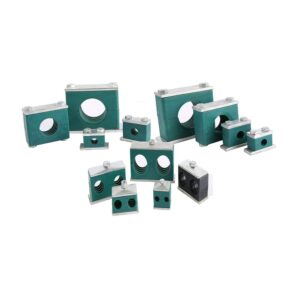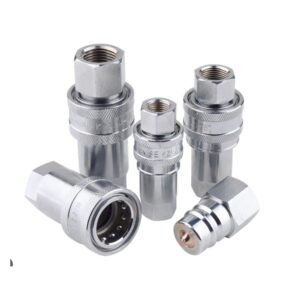Hoses, fittings, connectors and clamps need to be sized correctly for proper operation. Understanding the port size and working pressure of each system component is crucial for choosing the right hydraulic hoses and fittings.

Hidráulico accesorios help control and direct the flow of hydraulic fluid within the conductor, evitar fugas y mantener la presión.
Learn the basics of hydraulic fittings to select the best ones for your system. Fitting designs continue evolving to meet the latest safety and performance standards; therefore, it is important to ensure that you meet the strict demands of your application.
What is hydraulic hose connectors
Hydraulic connectors are essential parts of the hydraulic system that power your equipment, allowing hydraulic fluid (usually under high pressure) to transmit force and power where needed, including your final drive motors. These connectors are designed to withstand high pressure and ensure a leak-free connection.

Connection Types
Common types of hydraulic connectors include quick couplings, threaded connectors, flange connectors and push-to-connect fittings. Each type has its unique features and applications, which can be summarized into three basic types:
Threaded connector
Flange connector
Quick-disconnect connector
Quick couplings are widely used for their quick and easy connection and disconnection, while threaded connectors offer secure and reliable connections. Flanged connectors are often used in high-pressure applications, and push-to-connect fittings are convenient for rapid assembly.
Threaded connector

NPT Connections
En NPT (National Pipe Tapered) pipe thread has been widely used for over 100 years. NPT is the standard for tapered threads in the United States and is used for pipes and pipe fittings. They are used for effectively seal pipes for fluid and gas transfer. The nominal pipe size can be identified by measuring the thread diameter and then subtracting 1/4 inch.
They are available iron or brass, suitable for low-pressure applications; and there are also carbon steel and stainless steel types for high-pressure applications.
En NPTF (National Pipe Tapered Fuel) connection is widely used in fluid power systems. Its tapered thread achieves sealing through thread deformation. NPTF thread size measures the thread diameter, then subtract 1/4 inch, and you will obtain the nominal pipe diameter.
En NPSM (National Pipe Straight Mechanical) connections is also commonly used in fluid power systems. The female component adopts straight threads with an inverted 30° seat. The male component also uses straight threads and has a 30° internal chamfer. The seal is achieved by the compression of the 30° seat on the chamfer. This is a mechanical connection. If the male NPTF chamfering treatment, it can also achieve sealing with the NPSM female connection.
SAE Connections
The SAE J1926 straight thread O-ring Boss (ORB) is recommended by the National Fire Protection Association (N.F.P.A.) for leak prevention in medium and high-pressure hydraulic systems. The male connector is of a straight thread structure with an O-ring. The female port is also of a straight thread and has a machined surface to provide a smooth, flat surface (the minimum spotface) and chamfers at the O-ring installation area. When the male connector is connected to the female interface, the O-ring is compressed into the chamfer, thereby achieving sealing. This is also regarded as a mechanical connection method.
SAE J514 JIC/37° hydraulic connection is quite common in most hydraulic systems. Whether it is the male component or the female component, there is a 37° seats. The seal is made by establishing contact between the male flared and female coned seat. This is also regarded as a mechanical connection.
The SAE J512 45° connection fittings are commonly used in automobiles, refrigeration and trucks. These connection fittings are usually made of brass. Both the male and female connection fittings have a 45° seats, where the male flare and the female cone meet. This is also a type of mechanical connection.
NOTA: Los tamaños de los racores -02, -03, -04, -05, -08 y -10 de SAE 37° y SAE 45° tienen la misma rosca, pero NO el mismo ángulo de asiento. Mezclar los dos tipos de racores provocará fugas, así que tenga cuidado al medir los ángulos de asiento.
SAE J1453 (ORFS) O-ring Face Seal connections are considered be the most effective leakage control method. The male connector has a straight thread and an O-ring located within the face. The female has a straight thread and a machined flat face. The seal takes place by compressing the O-ring onto the flat face of the female, similar to the split flange type fitting. The threads maintain the connection mechanically.
SAE J512 Inverted connections are typically used in automotive systems. The male connector is either a 45° flare within the tube fitting or a 42° seat in the machined adapter. The female incorporates a straight thread with a 42° inverted flare. The fittings are sealed at the flared surfaces. These threads also maintain a mechanical connection.
SAE J518 4 Bolt Flange* These connections have two pressure ratings: Code 61 is regarded as the standard series, while Code 62 is the 6000 psi series. Each series has the same design, but the female interface of the 6000 psi high-pressure Code 62 connection has a larger flange head diameter and bolt hole spacing. The female interface of the joint is a smooth, unthreaded interface, with four rectangular bolt holes arranged around the interface. The male interface is a flange head with an O-ring groove, featuring separable or fixed flange halves and bolt holes matching the interface, and the seal is achieved by compression of the O-ring between the flange head and the interface plane. The connection is fixed by a threaded bolt.
BSP connection
En British Standard Pipe (BSP) and BSPT (tapered) connections are similar to NPT connections, but the thread pitch of most sizes is different. Although the OD’s and the thread form are similar, they are not exactly the same. Sealing takes place through the deformation of the threads. Therefore, it is recommended to use thread sealant when securing these connections.
BSPP (parallel) male connection is comparable to NPSM male except most sizes have a different thread pitch. A captive seal is made using metal to metal angled surfaces or a combination of metal to metal and an O-ring. This type of connection is very similar (but not interchangeable) with the American NPSM male. The female swivel BSPP has a tapered nose flareless swivel where the seal occurs on the cone seat of the male connector.
Conexiones japonesas
JIS Tapered Pipe (PT) adopts metric threads that comply with the JIS B 0203 standard. These are JIS tapered threads, whose dimensions and appearance are comparable to the design of the BSPT connection. JIS tapered thread connections can be interchanged with BSPT connections.
JIS 30° Male Inverted Seat connections is a parallel pipe thread in accordance with the JIS B 0202 standard. The JIS parallel connection is equivalent to the BSPP connection. The JIS parallel thread connection can be interchanged with the BSPP connection.
JIS 30° Female (Cone) Seat complies with the JIS B 0202 standard and belongs to the parallel pipe thread. The Japanese JIS 30° flared connection is similar to the American SAE 37° flared connection in terms of application and sealing principle. However, the angle and size of the JIS 30° flaring are different, and its thread is similar to the BSPP thread.
Brida de 4 pernos JIS B 8363 connections are frequently used in fluid power systems.
ISO Conexiones
ISO/DIS 6162 4-Bolt Flange is another common connection found in fluid power systems. There are two pressure ratings for this connection- Code 61: PN 35/350 bar which is considered the standard series and Code 62: PN 415 bar which is the high pressure series. They maintain the same design, yet with the bold hole spacings and flanged head diameters being larger on the PN 415 bar high pressure connection. Inch or metric bolts are found in these connections, however there is an “M” stamped on the port if metric bolts are to be used. The female port of the fitting is a smooth, un-threaded port with four bolt holes set in a rectangular pattern in around the port. The male is a flanged head with a groove for an O-ring to seat and either split or captive flange halves and bolt holes which match the port. The seal is made where the O-ring is compressed between the flanged head and the flat surface of the port. The connection is held by threaded bolts.
ISO 6149 Port and Stud Ends with ISO 261 Threads and O-ring Seal though it is similar to the SAE J514 Straight Thread O-ring Boss (ORB), this type of connection incorporates metric threads. The male connector has straight threads with an O-ring. The female port is also straight threads machined surface to provide a smooth, flat, accurately located surface (minimum spotface), along with a chamfer where the O-ring seats. It seals when the O-ring is compressed into the chamfer when mating the male connection. This is also considered a mechanical connection.
Flange Connectors

hydraulic flange connector are indispensable components in hydraulic systems, used to connect different parts of pipes, fittings or hoses. They ensure that the fluid can flow smoothly and under high pressure without any leakage. Unlike traditional connectors that use threads or crimping, hydraulic flange connectors achieve extremely tight and secure connections through flanges and bolts. This design makes installation and maintenance a breeze compared to other connection methods.
A hydraulic flange connector is an absolutely essential component that you cannot do without in hydraulic systems to connect different sections of pipe, tube, or hose. It ensures that fluids can pass through smoothly and without any leaks, even under high pressure. Unlike traditional connectors that use threaded or compression fittings, hydraulic flange connectors use a flange and bolts to establish an extremely tight and secure connection. This design makes installation and maintenance a breeze compared to other connection methods.
The flange part of the connector typically has a series of holes around its perimeter for bolts to pass through, securing the flange to a mating piece with a similar bolt pattern. This creates a robust seal that can handle the high pressures typical in hydraulic systems. The seal is often reinforced by placing O-rings or gaskets between the flanges to ensure no leakage.
Blind Flanges: This is a solid discs used to seal the end of a pipeline system or to close an opening. It is used to isolate different parts of a hydraulic system or to consider future expansion considered.
Captive Flanges: This type of flange is integrated into the hose fitting, providing a very secure connection and capable of withstanding high pressure. You will see them in applications with high vibration or high pressure.
Integral flange: This type of flange is manufactured together with the hose fitting, providing a secure and leak-proof connection. They are commonly used in high-pressure applications where connection reliability is essential.
Lap joint flanges: This type of flange is composed of two halves and is clamped onto the short pipe end of the pipeline. For applications where the connection needs to be disassembled frequently or where the material is difficult to weld, the butt-weld flange is the ideal choice.
SAE Flanges (Code 61 & Code 62): These flanges are designed in accordance with the standards of the Society of Automotive Engineers (SAE). The Code 61 flange is a standard pressure flange, while the 62-type flange is a high-pressure flange. Due to their reliable sealing performance and ease of assembly, these flanges are widely used.
Screwed flanges:These flanges are connected to the threaded end of the pipe via threads and are suitable for low-pressure applications.
Slip-on flanges: This type of flange is placed at the end of the pipe and then welded to the pipe wall. It is an ideal choice for applications where direct welding to the pipe is difficult.
Socket-weld flange: Before welding, insert the socket-weld flange into the groove of the valve, pipe fitting or pipeline. They are commonly used in high-pressure applications for smaller-diameter pipes.
Socket Weld Flanges: This type of flange is placed at the end of the pipe and then welded to the pipe wall. It is an ideal choice for applications where direct welding to the pipe is difficult.
Socket-weld flange: Before welding, insert the socket-weld flange into the groove of the valve, pipe fitting or pipeline. They are commonly used in high-pressure applications for smaller-diameter pipes.
Split Flanges: These consist of two halves bolted around the hydraulic hose or tube. Their design makes them easier to install and maintain in tight spaces or when large-diameter tubes or hoses are involved.
Square Flanges: Square flanges are used in systems requiring four-bolt flanges and requiring high pressure.
Threaded Flanges: These are screwed directly onto a pipe without welding and are used when welding is not possible.
Weld neck flanges: These flanges are welded directly to the pipe, providing a strong and leak-proof connection., and are often used in high-pressure applications.
Quick Disconnect Connectors

Quick disconnect connectors are also called quick couplings or quick-release couplings. Their job is facilitating easy, fast, and secure connections and disconnections of hoses and pipes without tools or specialized equipment. These connectors are essential in systems requiring frequent disconnection and reconnection of components, supporting flexibility, maintenance, and the ability to change or isolate parts of the system quickly.
Cara plana: These are engineered to eliminate spillage and air inclusion when connecting and disconnecting -- which can be extremely important from a hydraulic cleanliness viewpoint. They are ideal for applications requiring minimal contamination, such as in clean environments or with sensitive hydraulic circuits.
High-Pressure: as their name implies, these quick disconnects are used with extreme pressures They often feature robust construction and locking mechanisms to ensure a secure connection under high pressure.
ISO A (ISO 7241-1 Series A and B): These are widely used thanks to a poppet valve design that minimizes leakage during disconnections and connections. They are versatile and can be used in various hydraulic systems. The B series is similar to ISO A but with a slightly different profile, the ISO B connectors are also widely used and feature a poppet valve design. They are interchangeable with other ISO B connectors and are easy to clean and can minimize fluid spillage.
Series B is used predominantly in North America and the chemical industry, while Series A is mainly used in Europe and is preferred worldwide for agricultural and forestry machinery.
Push-Pull: Push-pull quick disconnect connectors are for easy connection and disconnection; just push or pull the connector halves. They are user-friendly and often used in applications requiring quick and frequent changes.
Screw Type: These use a threaded connection and are known for their ability to withstand high pressures and vibrations, making them suitable for heavy-duty applications.
Snap Type: These hydraulic connectors use a ball lock mechanism to connect and disconnect quickly. They are easy to use and provide a secure connection, suitable for low- to medium-pressure applications.
Wing Nut: Wing nut connectors are designed for frequent manual connection and disconnection. The wing nut allows easy tightening and loosening without needing tools.
Many Different Types of hydraulic hose connectors Fittings?
While there might be hundreds if not thousands of hydraulic fittings and connectors, they all boil down to three basic types.
These three types are either metal seal, soft seal, or tapered thread connectors. No matter which of these types of fittings yours belongs to, it will be required to satisfy two conditions: it must seal and it must hold. In some cases, the same mechanism can fulfill both functions, and in other cases, two different parts of the same mechanism will handle the necessary functions. Tapered pipe connectors are cut on a taper with a pipe's diameter, and it changes along the entire threaded portion of a pipe, in order to make the connection tighter.
These types of fittings require a sealer, so you can be sure there will be no leakage around the fitting, and this is usually accomplished with a chemical sealant or a tape sealant. While it might be difficult to orient the tapered pipe threads correctly, it's very important to do so, because a poor seal might result in leakage when pressure is applied. If there is a disadvantage to tapered pipe connections, it's that they must be either soldered or welded to tubes when making a connection. Metal seal connectors were invented largely to provide an alternative to tapered pipe thread varieties.
This type uses a tapered thread combined with a machined face, to provide a seal capable of handling the typical high pressure associated with hydraulics. The thread helps to accomplish the holding power, while the sealing is managed by the machined face. These kinds are easier to orient than a tapered connector, and they generally provide a better seal, without the need for any kind of additional sealant. However, they do still require welding or soldering to the tube. Soft seal are probably the most popular type used today, and these have an elastomeric seal that prevents leakage even under high-pressure situations. One of the big advantages to using soft seal connectors is that they can be installed very quickly, and this is highly advantageous in industrial applications. They are also capable of resisting heavy vibrations which many systems are subject to, so they don't break down nearly as frequently.
Choosing the right hydraulic hose connectors fitting
Choosing the right hydraulic fitting is crucial for a safe and efficient hydraulic system. Here’s a breakdown of the key factors to consider. Several of these considerations are summarized as a STAMP acronym:
- Size: This refers to the diameter and the thread type of the fitting. It should seamlessly match the hose or tubing you’re connecting. Common sizing standards include NPT, BSP, and metric (ISO), which are described above.
- Temperature: It is important to consider both the operating temperature of your system and the ambient temperature where the fitting will be used. Some materials may become brittle or lose strength at extreme temperatures.
- Application: Consider the fitting’s function within the system. Fittings designed to handle high-vibration environments may be required, while quick-connect options might be ideal for easy assembly and disassembly.
- Assembly: En función de la aplicación, ¿cómo se fijará el racor a la manguera o tubo? Los racores prensados son permanentes y duraderos, mientras que los racores reutilizables son más flexibles.
- METROaterial: The fitting material needs to be compatible with the hydraulic fluid being used and withstand the system’s pressure.
- PAGressure: The fitting’s pressure rating must exceed the maximum pressure your hydraulic system will generate. Selecting a fitting below the system’s maximum pressure can lead to catastrophic failure.
- Fluid: Different fluids have varying properties, which may affect the choice of fitting material. The fluid must be compatible with the fitting material to avoid corrosion or degradation.
By carefully evaluating these factors, you can select the most appropriate hydraulic fitting for your application. If you have any doubts about the selection process, it is recommended that you consult a hydraulics professional–especially for complex systems.
Sinopulse high-quality hydraulic hose connectors and fittings
If you are still unsure about which type of connector and fittings your equipment requires, we can assist you. Please contact Sinopulse and we will provide you with quality connectors that meet your needs.
Sinopulse offer a wide range of hydraulic hose connectors and fittings, suitable for various industrial environments. Our hydraulic hose fittings are manufactured in China factory, and are exported to over 150 countries worldwide. We are professional to produce high-quality hydraulic hose connectors , which can be used for hydraulic and pneumatic hoses of various sizes and applications, please feel free to contact us at any time.